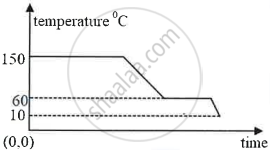Advertisements
Advertisements
प्रश्न
Observe the following graph and answer the following questions:

- What does the graph represent?
- What does the line AB represent?
- What does the line BC represent?
उत्तर
- The graph represents latent heat of phase transformation.
- Line AB represents the conversion of ice into water at constant temperature.
- Line BC represents the rise in temperature of water from 0° to 100°
APPEARS IN
संबंधित प्रश्न
State two characteristics of a good thermion emitter.
State the effect of an increase of impurities on the melting point of ice.
Write the approximate value of specific latent heat of ice.
Explain the following:
The surrounding become pleasantly warm when water in a lake starts freezing in cold countries.
The specific latent heat of fusion of water is ______.
Answer the following:
Explain the role of latent heat in the change of state of a substance.
Explain why water is used in hot water bottles for fomentation and also as a universal coolant.
Give one consequence of the high specific latent heat of fusion of ice.
The specific latent heat of vaporisation of steam is 2260 J/g. Comment on this.
Why does evaporation causes cooling and why is water used in hot water bottles?
What observation you will record and how will you determine the specific latent heat of fusion of ice?
When ice is converted into water : constant temperature : : before the water evaporates : _______
Specific latent heat of vaporisation : J/kg : : specific heat : _______
Find the odd one out and give its explanation.
2875 J of heat is required to melt 115 g of lead at its melting point. Calculate the specific latent heat capacity of fusion of lead.
The amount of heat energy required to melt a given mass of a substance at its melting point without any rise in its temperature is called as the ______.
The diagram below shows a cooling curve for a substance:

- State the temperatures at which the substance condenses.
- The temperature range in which the substance is in liquid state.
- Why do we prefer ice to ice-cold water for cooling a drink?
20 g of ice at 0°C absorbs 10,920 J of heat energy to melt and change to water at 50°C. Calculate the specific latent heat of fusion of ice. Specific heat capacity of water is 4200 J kg-1 K-1.
